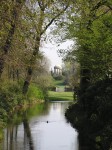 In the mid-1760s, Prince Leopold III of Anhalt-Dessau took his architect friend Friedrich Wilhelm von Erdmannsdorff on a Grand Tour of Europe, as was de rigeur for well-to-do youth of that time. They traveled through Italy, the Netherlands, England and France, absorbing the cultural lessons of antiquity and the Renaissance. Pompeii, which had been rediscovered only in 1748, and the ever-smoking Vesuvius that loomed in the background made a lasting impression on the young prince.
In the mid-1760s, Prince Leopold III of Anhalt-Dessau took his architect friend Friedrich Wilhelm von Erdmannsdorff on a Grand Tour of Europe, as was de rigeur for well-to-do youth of that time. They traveled through Italy, the Netherlands, England and France, absorbing the cultural lessons of antiquity and the Renaissance. Pompeii, which had been rediscovered only in 1748, and the ever-smoking Vesuvius that loomed in the background made a lasting impression on the young prince.
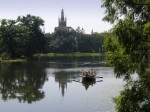 When he returned home to Wörlitz, the prince, Erdmannsdorff and landscape architect Johann Friedrich Eyserbeck set to creating a mini-Grand Tour in Leopold’s back yard. Inspired by Enlightenment ideals, the nature-as-educator philosophy of Jean-Jacques Rousseau and the English garden movement that valued pastoral beauty over the formal landscapes of the Baroque period, over the next decades the prince made almost his entire principality into a public garden with river-fed canals, Neoclassical buildings (including the family’s home castle and separate kitchen), a
When he returned home to Wörlitz, the prince, Erdmannsdorff and landscape architect Johann Friedrich Eyserbeck set to creating a mini-Grand Tour in Leopold’s back yard. Inspired by Enlightenment ideals, the nature-as-educator philosophy of Jean-Jacques Rousseau and the English garden movement that valued pastoral beauty over the formal landscapes of the Baroque period, over the next decades the prince made almost his entire principality into a public garden with river-fed canals, Neoclassical buildings (including the family’s home castle and separate kitchen), a 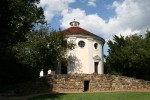 Chinese pagoda, a synagogue modeled after the Temple of Hercules Victor in Rome, a neo-Gothic Christian church, a miniature Pantheon with reliefs of gods both classical and Egyptian, temples dedicated to Flora and Venus, bridges in various styles, a labyrinth, and a lake with a bucolic Rousseau Island (a copy of the philosopher’s original tomb in Ermenonville; his body no longer rests
Chinese pagoda, a synagogue modeled after the Temple of Hercules Victor in Rome, a neo-Gothic Christian church, a miniature Pantheon with reliefs of gods both classical and Egyptian, temples dedicated to Flora and Venus, bridges in various styles, a labyrinth, and a lake with a bucolic Rousseau Island (a copy of the philosopher’s original tomb in Ermenonville; his body no longer rests  there as it was moved to the Panthéon in Paris after the French Revolution) in the middle.
there as it was moved to the Panthéon in Paris after the French Revolution) in the middle.
The project took decades to complete, but the final result was a conceptually unified monument to the Enlightenment view of history, art, nature and beauty as ennobling and educational for everyone from prince to pauper. Leopold opened the park to the public from the earliest days and even though it experienced some rough treatment and neglect in its East German period, it is again open today. The park, now a UNESCO World Heritage site known as the 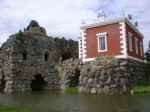 Garden Kingdom of Dessau-Wörlitz, is a 55-square-mile wonderland adorned with more than 40 follies and architectural features in diverse styles.
Garden Kingdom of Dessau-Wörlitz, is a 55-square-mile wonderland adorned with more than 40 follies and architectural features in diverse styles.
There’s one patch of the park which is particularly wondrous: a wee furnace-fed volcano. Twenty-plus years after his trip to Pompeii, Prince Leopold built himself a pet Vesuvius that could erupt on command. It took six years to make and was complete in 1794. The 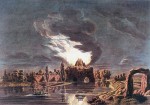 prince would have guests over to watch it erupt, but he left behind no specifics on how exactly he made the fireworks happen. Only one contemporary painting of the event survives and one jeering but helpfully detailed review from a critic.
prince would have guests over to watch it erupt, but he left behind no specifics on how exactly he made the fireworks happen. Only one contemporary painting of the event survives and one jeering but helpfully detailed review from a critic.
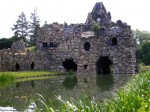 After Leopold’s death in 1817, his Vesuvius went dormant due to his heir’s lack of interest in the spectacle. The park was maintained for the next century and a half, but the volcano not so much. The garden as a whole survived World War II relatively unscathed. The worst treatment it received was at German hands when the synagogue’s interior was destroyed during Kristallnacht in November of 1938. It was only the courageous intervention of the park’s director, Hans Hallervorden, that kept the building itself from being destroyed; he was promptly fired for his trouble.
After Leopold’s death in 1817, his Vesuvius went dormant due to his heir’s lack of interest in the spectacle. The park was maintained for the next century and a half, but the volcano not so much. The garden as a whole survived World War II relatively unscathed. The worst treatment it received was at German hands when the synagogue’s interior was destroyed during Kristallnacht in November of 1938. It was only the courageous intervention of the park’s director, Hans Hallervorden, that kept the building itself from being destroyed; he was promptly fired for his trouble.
After the war, the closest the volcano came to erupting again was when its new East German masters burned some tires in the furnace. Charming spectacle, I’m sure, and how fragrant. I’m sure the crowds came for miles to see the tire fire. By 1983, the volcano was condemned. Some rocks had fallen and killed a visitor, so that was that.
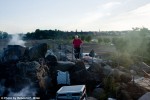 In 2004, the park management decided to enlist the aid of Brandenburg Technical University chemistry professor Wolfgang Spyra to reignite the volcano’s fires.
In 2004, the park management decided to enlist the aid of Brandenburg Technical University chemistry professor Wolfgang Spyra to reignite the volcano’s fires.
“A volcano that can’t explode is a very sad volcano, and I wanted to make it happy again,” Spyra says. “We wanted to help the volcano get its identity back.”
Could he be any more awesome? Answer: yes, because he signs his emails “the Eruptor.” I heart this man.
Spyra researched the historical eruptions, and using the one painting and the one critic’s review, he was able to get a solid idea of the dimensions of the eruptions. He investigated what kind of firepower Leopold would have had available to him, and how the three furnaces underneath the volcano and the reservoir of water in front of the crater were used to create the impression of explosion and lava flow.
So in the summer of 2005, pet Vesuvius erupted again, now with the addition of sound effects through speakers.
Then, with a final rumble of drums and thunder, the moment arrives: red flames flickered at the top of the volcano, growing into a thick column of smoke.
Red-tinged water begins to flow from the crater, churning the still lake below. Sharp, loud explosions send sparks shooting into the sky. Hidden in the volcano’s peak is an 86-square-foot oven packed with fresh pine needles. Once lit, they roar into smoky fire, sending sparks high into the night sky along with the billowing smoke.
As the needles burn above their heads, Brandenburg Technical University students in gas masks rush from fireplace to fireplace in the room below, squirting lighter fluid on blazing wood fires and tossing in special powder to create brightly colored smoke that pours out from underneath the summit of the volcano.
Then, red-tinged water begins to flow from the crater, churning the still lake below. To create the illusion of flowing lava, Spyra first filled the artificial pond at the top of the crater. As the volcanic “eruption” peaks, the water is released over a ledge to form a waterfall, lit from behind by bright red Bengal fire.
Throughout, sharp, loud explosions send sparks shooting into the sky, jolting onlookers with each loud bang. The effect is produced using mortars, familiar to any 18th-century artillery expert.
Every year the volcano erupts again, but they don’t announce the exact date and time because, duh, volcanoes don’t give warnings. People lucky enough to be in the vicinity of the park when the rumblings begin just hightail it to the shores of the lake to enjoy the show.
Here’s this year’s eruption, which took place on the anniversary of the eruption that destroyed Pompeii. I think the eruption from 2010 is more dramatic, so I’ve embedded it below.
[youtube=http://www.youtube.com/watch?v=3EJxrx_c3b8&w=430]